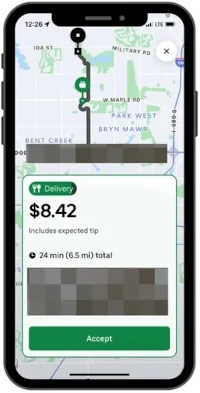 Vasu Virda is a delivery driver for Uber Eats in Vancouver. When he is sent a delivery offer by the company he must accept it by tapping the Uber Eats app on his cellphone. He did this while being observed by Officer Kim who issued a traffic ticket for using an electronic device while driving.
Vasu Virda is a delivery driver for Uber Eats in Vancouver. When he is sent a delivery offer by the company he must accept it by tapping the Uber Eats app on his cellphone. He did this while being observed by Officer Kim who issued a traffic ticket for using an electronic device while driving.
Mr. Virda disputed the ticket and went to trial in front of Judicial Justice Makhdoom. The Justice found that Mr. Virda found him not guilty because the Motor Vehicle Act allowed a person using a handheld cellphone to touch it once while they were operating a vehicle.

Use of Electronic Devices While Driving Regulation
7 (1) Subject to section 6 and subsection (2), a person may use an electronic device in a hands-free telephone function while driving or operating a motor vehicle on a highway, if the device
(b) is voice-activated or requires only one touch in order to initiate, accept or end a call,
Argument to the Contrary Not Successful
Officer Kim attempted to explain that this only applied to accepting a cellphone voice call and did not include using an app. The Justice did not accept the argument because he had already acquitted Mr. Virda.
Appeal of the Acquittal
The Crown appealed saying that the Justice had erred on two grounds. The first is that the law does not permit the use of the Uber app in this situation and the second is that the Justice made his decision before hearing from Officer Kim.
Cellphone Voice Call Exemption
Justice Baker agreed that Section 7 of the regulations only permitted the one touch exemption to apply to cellphone voice calls and not the use of an app.
She also found that Justice Makhdoom did not hear submissions from both parties at the original trial.
On that basis she set aside the original acquittal and entered a conviction because she was satisfied that there was enough evidence at the original trial to do so.
Learn More
Share This Article
I presume that this interpretation of the law would then apply to taxi drivers as well. I do wonder why police officers, who have both computers and radio systems, not to mention cell phones, can possibly function safely while driving. Yes, they are trained better, but distraction is distraction. it does seem a bit unfair for the legislation to be applied selectively. If a police vehicle is involved in a collision or crash do we automatically investigate whether the driver was using one of these devices. they certainly do with private citizens.
- Log in to post comments
I agree with you about police too. When I worked the lid on the laptop was down when I was driving and pulled over to make cell phone calls. The radio was something that I did use while driving and sometimes could not avoid it. One such situation was to keep everyone up to date when I was trying to stop a driver that did not want to stop.
- Log in to post comments
The whole Uber business model depends on not following laws.
People don't seem bothered that the Ride Share industry doesn't work financially if they are held to all the same regulations that apply to companies in the Passenger Transportation business. They just set up in cities and rely on public opinion and pressure to persuade the government to accommodate Uber's business model.
Glad the judge overturned the ruling. I just hope Uber doesn't open an airline.
- Log in to post comments
I totally understand the judge's position on applying the law as written, but also feel it is a poorly written law.
Many vehicles come equipped with giant, obtrusive touch screens (think Tesla) to control basic vehicle functions. There is a general industry push towards interactive displays (I refuse to call them "smart"). It's been many years since people started to question the safety of touch screens versus buttons in vehicles and there's scientific studies to back that up and some manufacturers are reintroducing buttons and knobs.
Regarding the law in question, others have already questioned the use of digital meters by taxi drivers. We all know phones can be paired to the vehicle's console, allowing the use of the standard vehicle equipment and controls to handle phone calls, read and reply to messages and more.
And now at least one automotive brand is using them to show intrusive ads. This would seem to take no more human effort than reading and acknowledging a text message on a phone while stopped, which is presently illegal under the law.
If the phone functions are controlled via the dashboard, is the operator in compliance with the law? What about additional functions like reading or replying to texts or using driving directions/mapping apps?
It would seem that if the manufacturers feel empowered to show ads on the console that is an inherent conflict with attentive driving. If Android Auto and Apple CarPlay enable App developers to port their phone applications to their automotive OSes, then what applicability does the law have? It is certainly mentally/operationally no different to look at an app on a phone mounted to the console to looking at the same app of the vehicle console, although human factors wise, the portable device (ie: phone) can probably be located closer to the line of sight, resulting in shorter distraction times.
At what point can a police officer use other tools, like plain old Distracted Driving rules for a driver's interaction with the vehicle console? It would seem the Distracted Driving rules could even apply to operating the basic vehicle functions via console.
All this points to the need to rewrite the law, not just to reflect the changes in technology but also the rather consistent human factors involved in the tasks drivers perform. It would be refreshing to see Transport Canada step up and push back against auto manufacturers but they can't even keep up with the much more trivial evolution of vehicle headlights.
- Log in to post comments
In a positive turn,
Volkswagen reintroducing physical controls for vital functions
Brand's design chief commits to "never" repeating the "mistake" of relegating essential controls to touchscreens
All future Volkswagen models will feature physical controls for the most important functions, design chief Andreas Mindt has said.
When will North American regulators follow in their European counterparts' footsteps?
Cars will need fewer screens and more buttons to earn 5-star safety rating in Europe
Euro NCAP will introduce new testing rules in 2026 that require vehicles to have physical controls to earn the highest safety score.
- Log in to post comments
- Log in to post comments

Cellphone Use by Food Delivery & Uber Drivers